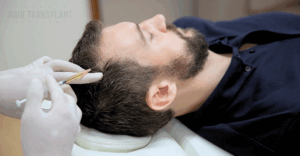Inflammation and Hair Loss: Causes & Treatment Options – Toronto Hair Transplant Surgeons
Hair loss is a common problem for many individuals, and its causes can vary significantly. One factor that is often overlooked is inflammation and its impact on hair loss. Inflammation is the body’s natural response to infection, but when it becomes chronic, it can have detrimental effects on hair follicles in particular. Inflammation acts as a protective mechanism against injury or infection, but when this response becomes chronic, it can be harmful to the body, including the hair follicles. Male and female pattern hair loss is the most common cause of hair loss, affecting nearly 80 million people in the US. This article aims to shed light on the connection between inflammation and hair loss, exploring hair loss causes, its impact on the hair growth cycle, signs to look out for, and hair loss cure options.
Common Causes of Hair Loss
Before delving into the relationship between inflammation and hair loss, it is important to understand the common causes of hair loss. Hair disorders encompass a wide range of conditions affecting the scalp and hair, and several factors can contribute to hair loss, including genetic predisposition, hormonal imbalances, nutritional deficiencies, and certain medical conditions. Non scarring alopecia is the primary process in male and female pattern hair loss, leading to thinning hair without scarring. Male pattern baldness commonly affects adult men, while central centrifugal cicatricial alopecia commonly affects Black women, and frontal fibrosing alopecia primarily affects postmenopausal women. Starting or stopping birth control pills can trigger telogen effluvium, a type of hair loss. Traction alopecia is a form of hair loss caused by tight hairstyles that pull on the hair. Scalp ringworm (tinea capitis), a fungal infection, commonly affects children and can cause hair loss, redness, and itching; fungal infection of the scalp may require antifungal treatment. Stress, excessive styling, and harsh chemical treatments can also play a role in hair loss. It’s important to identify the root cause and to determine the most effective treatment approach, as understanding the amount of lost hair versus regrowth is crucial for managing these conditions. Central centrifugal cicatricial alopecia and frontal fibrosing alopecia are specific types of hair loss that may require specialized care.
Types of Hair Loss
Hair loss, or alopecia, can present in several different forms, each with its own underlying causes and patterns. The most common type is male pattern baldness, also known as androgenetic alopecia, which typically results in a receding hairline and thinning at the crown in men. Female pattern hair loss, on the other hand, usually causes diffuse thinning across the scalp rather than distinct bald patches. Both of these types are influenced by genetics and hormonal changes, and they commonly affect adults as they age. Androgenetic alopecia, also known as male or female pattern baldness, is the most common type of non-scarring alopecia.
Alopecia areata is another form of hair loss that occurs when the immune system mistakenly targets the hair follicles, leading to sudden, patchy hair loss on the scalp or other areas of the body. This autoimmune disorder can affect people of all ages and often appears without warning. Scarring alopecia, also known as cicatricial alopecia, is a less common but more severe type of hair loss. In this condition, inflammation destroys hair follicles and replaces them with scar tissue, resulting in permanent hair loss. Scarring alopecia can be caused by various factors, including autoimmune disease, infections, or other inflammatory skin disorders.
Understanding the specific type of hair loss you are experiencing is essential for choosing the most effective treatment options and for protecting the health of your hair follicles.
Autoimmune Disorders and Hair Loss
Autoimmune disorders can have a significant impact on hair growth and the health of hair follicles. In conditions like alopecia areata, the immune system mistakenly attacks the hair follicles, disrupting the normal hair growth cycle and causing hair to fall out in small, round patches. This process can affect not only the scalp but also other areas where hair grows, and it may lead to rapid hair loss or even complete baldness in severe cases.
Other autoimmune diseases, such as rheumatoid arthritis and lupus, can also contribute to hair loss. These conditions often cause chronic inflammation and skin irritation, which can weaken hair follicles and interfere with new hair growth. In some cases, the inflammation is so severe that it leads to scarring alopecia, where the destruction of hair follicles results in permanent hair loss.
Treating hair loss caused by autoimmune disorders typically involves therapies that help reduce inflammation and suppress the immune response. Medications such as corticosteroids or other immunosuppressants may be prescribed to manage symptoms and protect hair follicles. Additionally, advanced treatments like low level laser therapy and platelet rich plasma therapy are sometimes used to stimulate new hair growth and support the recovery of affected areas. Topical minoxidil and oral finasteride are the only treatments recognized by the FDA for MPHL and FPHL. Working closely with a healthcare provider is crucial to develop a personalized treatment plan that addresses both the underlying autoimmune condition and the resulting hair loss.
The Link Between Inflammation and Hair Loss
Inflammation can directly impact the hair follicles and disrupt the hair growth cycle. When the body experiences inflammation, it releases pro-inflammatory cytokines, which can damage the hair follicles and impede their ability to produce healthy hair strands. Inflammatory cells such as lymphocytes and mast cells infiltrate the scalp and contribute to follicle damage. Severe inflammation can significantly impair hair follicle health and accelerate hair loss. Additionally, chronic inflammation can trigger an autoimmune response, leading to conditions like alopecia areata, where the immune system mistakenly attacks the hair follicles. Inflammation is also a characteristic feature of male and female pattern hair loss (MPHL and FPHL). Understanding this link between inflammation and hair loss is crucial in developing effective treatment strategies.
Understanding the Hair Growth Cycle
Before delving deeper into the impact of chronic inflammation on hair follicles, it is important to have a basic understanding of the hair cycle. The hair cycle consists of 3 main phases: anagen (also known as the growth phase), catagen (transition), and telogen (resting). Inflammation can disrupt the hair cycle by shortening the growth phase (anagen phase) and prolonging the telogen phase. This shortening of the growth phase leads to thinner, weaker hair strands and reduced hair density. Repeated inflammation or damage to the same follicle can result in increased hair shedding and thinning. Targeting inflammation can make it possible to restore the balance of the hair cycle and promote healthier hair growth.
The Impact of Chronic Inflammation on Hair Follicles
Chronic inflammation can have a severe impact on hair follicles. As inflammation persists, it can lead to fibrosis, a process where excess collagen is deposited around the hair follicles, inhibiting their function. This fibrotic scarring can further impede hair growth and contribute to permanent hair loss. Moreover, chronic inflammation can disrupt the blood supply to the hair follicles, depriving them of essential nutrients and oxygen. Tissue samples, such as scalp biopsies, are often used to assess the extent of inflammation and follicle damage in hair loss conditions. Significant follicular infiltration of CD4+ T-cells has been observed as a source for impaired hair cycle in MPHL and FPHL. These detrimental effects highlight the importance of addressing inflammation in hair loss treatment.
Identifying Signs of Inflammation-Related Hair Loss
Identifying the signs of inflammation-related hair loss is crucial in determining the appropriate treatment approach. Some common signs include scalp redness or irritation, itching, and tenderness. Excessive shedding, thinning hair, and noticeable bald patches indicate inflammation-related hair loss. If you notice any of these signs, it is essential to consult with a medical doctor (such as a dermatologist) for an accurate diagnosis and treatment plan.
Treating Inflammation-Related Hair Loss
Treating inflammation-related hair loss requires a multi-faceted approach that addresses both the underlying inflammation and promotes hair growth. Home remedies may help decrease inflammation and encourage a healthy scalp, while professional treatment options, such as corticosteroid injections or topical immunotherapy, may be recommended by healthcare professionals to target inflammation directly.
Hair Loss Solution for Females Experiencing Inflammation-Related Hair Loss
Inflammation-related hair loss can affect both males and females, but the treatment approaches may differ due to hormonal variations. Females experiencing inflammation-related hair loss benefit from a combination of treatments, including anti-inflammatory medications, hormonal therapy, and topical solutions. Females should seek advice from a healthcare professional who specializes in hair loss to pinpoint the cause and create a suitable treatment strategy.
Inflammation’s Role In Hair Loss
How Big of a Role Does Inflammation Play in Hair Loss?
If you’ve done any research on male pattern balding (MPB), you’ve likely heard inflammation is a major cause of hair loss in men. Indeed, inflammation is involved in many undesirable conditions, including acne, asthma, and arthritis.
While dihydrotestosterone (DHT) is indisputable as the cause of men’s hair loss, it’s not necessarily the hormone itself that causes hair loss. Rather, DHT attacks the hair follicles and causes them to become inflamed, which in turn causes the follicles to shrink and the hair shaft to weaken. This process leads to hair thinning and eventually disappearing altogether.
This being the case, a lot of men are looking for ways to reduce inflammation on their scalp hoping to halt or reverse their hair loss. Below are some of the best ways to deal with inflammation.
How to tackle inflammation
- Diet
A poor diet is a big source of inflammation in the body. The average Western diet is full of processed foods that cause inflammation in the body. Eating a diet that’s rich in omega-3 fatty acids and antioxidants will help produce the optimum conditions in the body for hair growth. Good foods and supplements to take include cod liver oil, blueberries, walnuts, yogurt, turmeric and green apples.
- Ketoconazole shampoo
Ketoconazole shampoos are an excellent way to treat scalp inflammation topically. Ketoconazole is often used as a way to treat dandruff because of its anti-inflammatory properties, but it’s also great for hair loss. Many people who use a ketoconazole shampoo will notice a thicker appearance to their hair and that they shed much less.
- Finasteride
Finasteride (AKA Propecia) is a drug that inhibits DHT at a systematic level. While it doesn’t address inflammation directly, the reduced DHT in the body will mean less DHT on the scalp and, therefore, less inflammation. It is one of the few clinically proven treatments on the market to treat male pattern balding.
- Minoxidil
Minoxidil is the generic name for a topical solution applied to the scalp used to prevent hair loss in those with male pattern hair loss or female pattern hair loss. It is also used to regrow hair in people with genetic hair loss, or androgenetic alopecia. When used daily for 3-6 months or more, it is effective at preventing hair loss and stimulating hair growth. Topical minoxidil solution is one of only two Health Canada and FDA-approved medications specifically designed for regrowing hair. The most common brand name for topical minoxidil solution is Rogaine.
Preventing Hair Loss
Taking proactive steps to prevent hair loss can make a significant difference in maintaining healthy hair and supporting new hair growth. One of the most important factors is following a balanced diet rich in essential vitamins and minerals, such as vitamin D, biotin, and iron, which are vital for strong hair production and the health of hair follicles. Incorporating a variety of nutrient-dense foods into your daily meals can help ensure your hair receives the nourishment it needs to grow and thrive.
Managing stress is another key component in preventing hair loss. Chronic stress can disrupt the hair growth cycle and trigger conditions like telogen effluvium, where hair falls out more rapidly than usual. Techniques such as meditation, yoga, and regular exercise can help reduce stress levels and support overall well-being.
Gentle hair care practices are also essential. Avoiding harsh chemical treatments, minimizing heat styling, and using mild shampoos and conditioners can help protect hair shafts from damage and prevent thinning hair. For those experiencing early signs of hair loss, medical treatments like minoxidil and finasteride may be recommended by a healthcare provider to help treat hair loss and encourage new hair growth.
Regular check-ups with a healthcare provider are important for monitoring hair health and identifying any underlying medical conditions that could be contributing to hair loss. By combining healthy lifestyle habits, proper hair care, and professional guidance, you can take control of your hair’s health and reduce the risk of future hair loss.
FAQs
Can stress contribute to inflammation-related hair loss?
Yes, chronic stress can trigger inflammation and contribute to hair loss. Managing stress levels through relaxation techniques or therapy can help to reduce inflammation and also promote hair growth.
Are there any specific foods that can reduce inflammation and promote hair growth?
Foods rich in antioxidants, omega-3 fatty acids, and vitamins like C and E can help reduce inflammation and support hair growth. Examples include salmon, berries, spinach, and nuts.
Will inflammation-related hair loss recur after treatment?
Inflammation-related hair loss can recur if the underlying cause is not properly addressed or if there is ongoing exposure to inflammatory triggers. It is crucial to follow a comprehensive treatment plan and make necessary lifestyle changes to prevent recurrence.
Is inflammation-related hair loss permanent?
Inflammation-related hair loss can be reversible if addressed promptly and appropriately. However, if left untreated for an extended period, it can lead to permanent hair follicle damage and irreversible hair loss.
Conclusion
Understanding the role of inflammation in hair loss is important for effective treatment and prevention measures. By recognizing the signs of inflammation-related hair loss, addressing underlying causes, and adopting a multi-faceted approach, individuals can combat inflammation and promote healthy hair growth. Whether through natural remedies, dietary changes, or professional treatments, taking proactive steps can help slow or reverse hair loss and restore your confidence. Remember to seek advice from a dermatologist or healthcare professional to determine the best course of action for your specific needs. Take charge of your hair’s health and say goodbye to inflammation-related hair loss.






